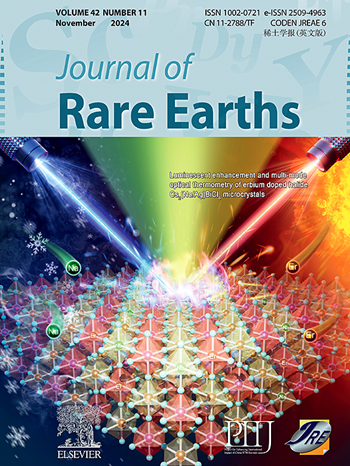Aggregation behavior of Ce–Mg–Mn–O–S composite inclusions in silicon-killed bearing steel and their evolution during heat treatment
IF 5.2
1区 化学
Q1 CHEMISTRY, APPLIED
引用次数: 0
Abstract
In order to mitigate the harm of alumina, calcium aluminate, and magnesium aluminum spinel inclusions on the fatigue performance of bearing steel, the effect of Ce–Mg composite treatment on the cleanliness of silicon-killed GCr15 bearing steel and the evolution of Ce–Mg–Mn–O–S composite inclusions during heat treatment of the steels at 1523 K were investigated in this present work. The results indicate that the cleanliness of S2 with 0.0045 wt% Ce and 0.0016 wt% Mg is better than that in S1 with 0.0020 wt% Ce and 0.0011 wt% Mg, which is attributed to the more effective removal of Ce–Mg–Mn–O–S composite inclusions, with help of good aggregation capacity of Ce-containing inclusions and small volume density of Mg-containing inclusions, due to the increase of rare earth and magnesium content. The aspect ratio and area fraction of the Ce–Mg–Mn–O–S composite inclusions in as-cast steel decrease significantly with isothermal treatment at 1523 K for 150 min, due to the effect of (i) Ostwald aging mechanism of inclusions and (ii) sulfide solid solution during isothermal treatment. With the increase of isothermal treatment time from 150 to 550 min, the aspect ratio and area fraction of the inclusions in S0 (untreated steel) and S1 decrease slightly, because spheroidization and solid solution of inclusions reach their basic equilibrium at 1523 K. However, the aspect ratio and area fraction of the Ce–Mg–Mn–O–S composite inclusions in S2 actually increase, and the inclusions evolve into three-phase (two-phase) inclusions, which is attributed to (iii) transformation of phase compositions in inclusions and interfacial reaction between inclusions and steel matrix during isothermal heating. Therefore, the control of inclusions in silicon-killed bearing steel with Ce and Mg composite treatment should be combined with specific heat treatment processes and appropriate rare earth and magnesium contents, to minimize the damage of inclusions on the fatigue performance of bearing steel products.

硅杀菌轴承钢中 Ce-Mg-Mn-O-S 复合夹杂物的团聚行为及其在热处理过程中的演化过程☆。
为了减轻氧化铝、铝酸钙和镁铝尖晶石夹杂物对轴承钢疲劳性能的危害,研究了Ce-Mg复合处理对硅杀灭GCr15轴承钢清洁度的影响,以及钢在1523 K热处理过程中Ce-Mg - mn - o - s复合夹杂物的演变。结果表明,Ce含量为0.0045 wt%、Mg含量为0.0016 wt%的S2的净净度优于Ce含量为0.0020 wt%、Mg含量为0.0011 wt%的S1,这是由于稀土和镁含量的增加,使Ce- Mg- mn - o - s复合夹杂物具有良好的聚集能力和较小的体积密度,从而更有效地去除了Ce- Mg- mn - o - s复合夹杂物。在1523 K、150 min等温处理下,铸态钢中Ce-Mg-Mn-O-S复合夹杂物的长径比和面积分数显著降低,这是由于等温处理过程中夹杂物的奥斯特瓦尔德时效机制和硫化物固溶体的影响。随着等温处理时间从150 ~ 550 min的增加,S0(未处理钢)和S1中夹杂物的长径比和面积分数略有下降,这是由于夹杂物的球化和固溶化在1523 K时达到基本平衡。而S2中Ce-Mg-Mn-O-S复合夹杂物的长径比和面积分数反而增大,并演变为三相(两相)夹杂物,这主要是由于在等温加热过程中夹杂物相组成发生转变,夹杂物与钢基体发生界面反应所致。因此,控制经Ce、Mg复合处理的硅杀轴承钢中夹杂物应结合特定的热处理工艺和适当的稀土、镁含量,以尽量减少夹杂物对轴承钢产品疲劳性能的损害。
本文章由计算机程序翻译,如有差异,请以英文原文为准。
求助全文
约1分钟内获得全文
求助全文
来源期刊

Journal of Rare Earths
化学-应用化学
CiteScore
8.70
自引率
14.30%
发文量
374
审稿时长
1.7 months
期刊介绍:
The Journal of Rare Earths reports studies on the 17 rare earth elements. It is a unique English-language learned journal that publishes works on various aspects of basic theory and applied science in the field of rare earths (RE). The journal accepts original high-quality original research papers and review articles with inventive content, and complete experimental data. It represents high academic standards and new progress in the RE field. Due to the advantage of abundant RE resources of China, the research on RE develops very actively, and papers on the latest progress in this field emerge every year. It is not only an important resource in which technicians publish and obtain their latest research results on RE, but also an important way of reflecting the updated progress in RE research field.
The Journal of Rare Earths covers all research and application of RE rare earths including spectroscopy, luminescence and phosphors, rare earth catalysis, magnetism and magnetic materials, advanced rare earth materials, RE chemistry & hydrometallurgy, RE metallography & pyrometallurgy, RE new materials, RE solid state physics & solid state chemistry, rare earth applications, RE analysis & test, RE geology & ore dressing, etc.
 求助内容:
求助内容: 应助结果提醒方式:
应助结果提醒方式:


